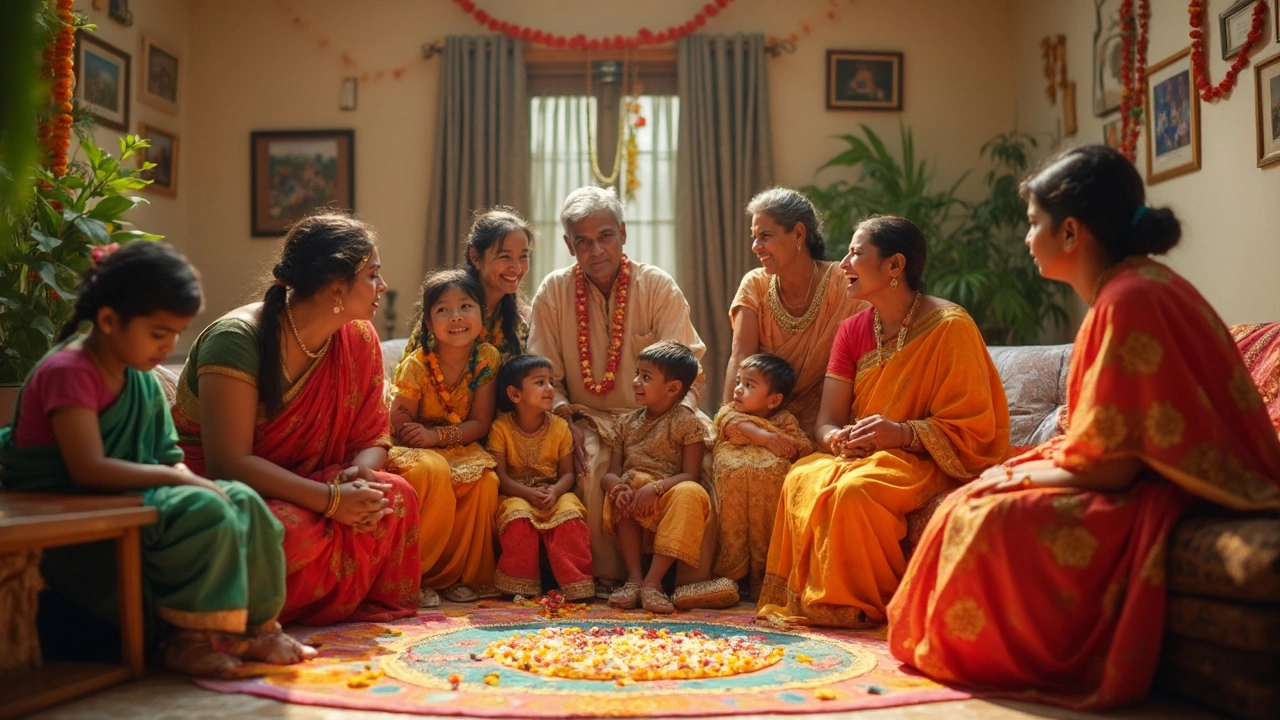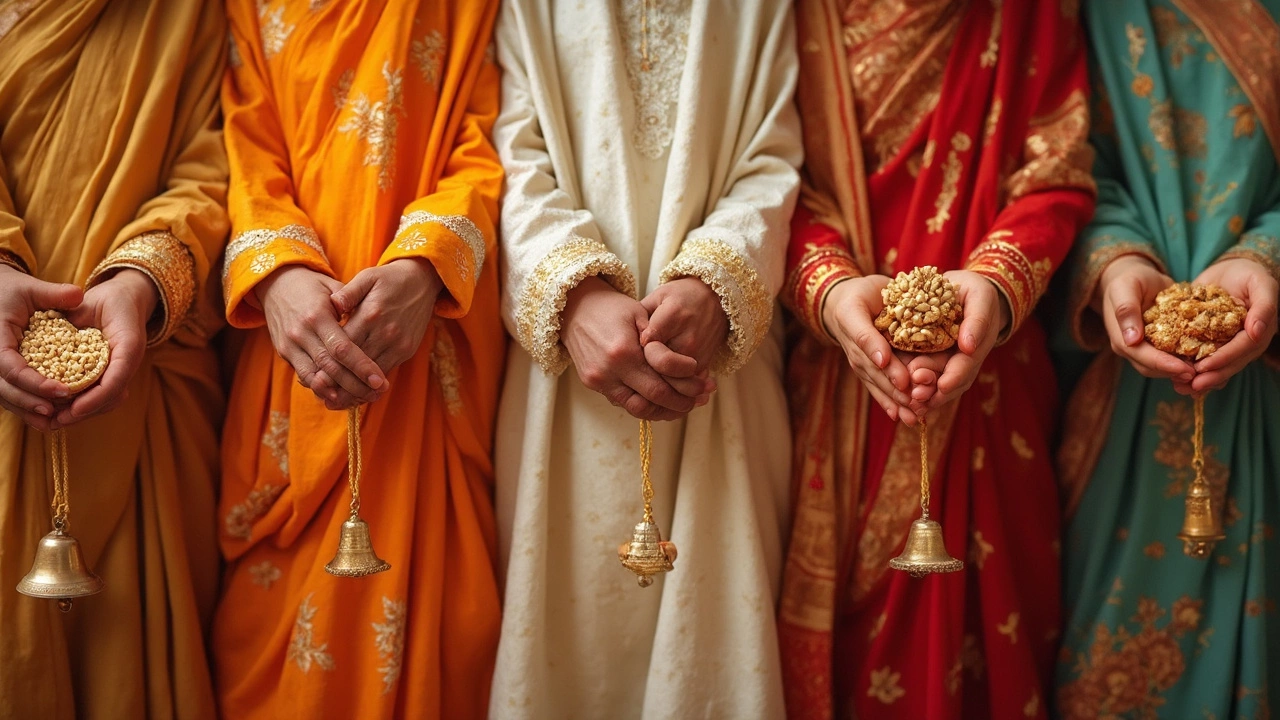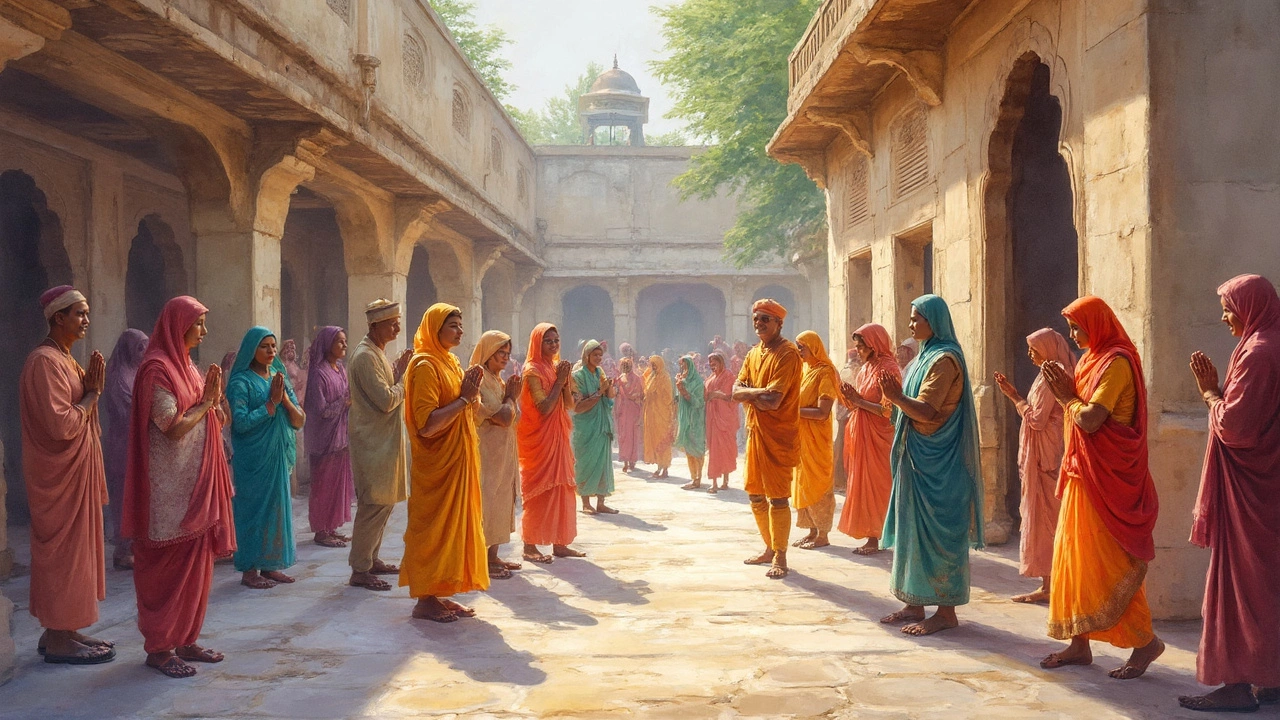If you’ve ever stepped into a traditional Indian home or temple, you’ve probably noticed people are pretty thoughtful about what they wear—and it’s not just about looking good. Clothing in Hindu culture does a lot of talking: it shows respect, signals who’s visiting or hosting, and even hints at the vibe of the day.
For Hindus, treating others with care often starts long before the first handshake. It’s visible in the way someone might reach for a kurta or sari when company comes over. The clothes send a message: you matter, and I want to honor you. Not sure what’s expected at a Diwali party or a prayer gathering? There’s a reason behind every fold and drape, and it’s more straightforward once you know what to look for.
Confused about dress codes for Indian celebrations? You’re not alone. There are rules, but they’re less about strict fashion police and more about making everyone feel included. Once you catch on to the basic ideas—like covering the shoulders or sticking with certain colors for holy days—you’ll feel more at home and know how to show proper respect without feeling out of place.
- Clothing as a Form of Respect
- Dressing for Different Occasions
- Modesty and Meaning in Fabric Choice
- Welcoming Guests: Hospitality in Dress
- Modern Twists on Old Traditions
Clothing as a Form of Respect
In Hindu culture, what you wear doesn’t just cover your body—it sends a message about your attitude toward other people. There’s a strong unwritten rule that putting on clean, tidy traditional Indian clothing isn’t just about self-presentation—it's a way to show respect for others, especially at social gatherings and religious sites.
Take the Hindu value of "saucha," which means cleanliness. It’s not only about bathing or washing hands, but also about wearing fresh clothes when you’re with family or guests. Nobody wants to sit down at a religious festival in jeans and a T-shirt while everyone else is in saris and kurtas. In most temples, there’s even a sign by the entrance reminding visitors to wear covered, modest clothing.
If you’re heading to someone’s house for a special occasion—think Raksha Bandhan, wedding, or a pooja—it’s common to:
- Pick clothes that are freshly washed.
- Wear outfits that cover shoulders and knees.
- Choose bright, cheerful colors (like maroon, yellow, or green) for happy events and white for more somber ones.
Numbers say a lot too. According to a 2022 survey by India Today, 76% of urban families still switch to traditional clothing for big religious occasions, and 61% say they do it to show respect to elders.
| Event | Common Clothing | What It Signals |
|---|---|---|
| Temple Visit | Kurta for men, sari/salwar kameez for women | Respect for the sacred space and others |
| Family Gathering | Neat kurta, simple sari | Honoring family tradition |
| Religious Festival | Colorful traditional outfits | Bringing joy and togetherness |
This isn’t just for show. If someone shows up in sloppy or too-revealing clothes, it’s seen as disrespectful—almost like ignoring basic manners at dinner. Dressing with care says, "You matter to me, so I made an effort." That’s a huge deal in Indian culture and keeps social vibes positive and welcoming.
Dressing for Different Occasions
One thing you notice fast in India—there’s no “one-outfit-fits-all.” What you wear depends a lot on where you’re headed and who you’ll meet. Clothes aren’t just about style; they’re a sign of respect for the event, the people, and the space.
Take religious places, for example. When visiting a temple, it’s common to wear clean, modest fabrics. For women, that usually means saris or salwar suits with shoulders covered and longer hemlines. Men often pick a simple kurta and pajama or even a dhoti, sticking to lighter or plain colors. Jeans and revealing tops? Those are usually considered off-limits for both genders at temples.
Family get-togethers and festivals are another story. People bring out bolder colors and more decorative outfits—think embroidered kurtas, lehengas, and sherwanis. Weddings? Expect the fanciest options, with lots of gold threads, beading, and even family heirlooms.
- Hindu weddings: Women often wear silk saris or lehengas in red, pink, or gold. Men go for ornate sherwanis, dhotis, or kurtas with matching stoles.
- Festival days (like Holi or Diwali): Outfits are vibrant and comfy so you can move easily—cotton for Holi (since things get messy), silk or blended fabrics for Diwali.
- Funeral attire: White, simple, and no glitz—white is the color of mourning for most Hindus, and this is a time for understated dress.
- Everyday wear: Saris, salwar kameez, kurtas, or even jeans for younger city folks at home or around friends, but still neat and in decent condition.
Here’s a quick peek at typical clothing choices for different occasions:
| Occasion | Common Outfits (Women) | Common Outfits (Men) |
|---|---|---|
| Temple Visit | Sari, Salwar Kameez, Scarf/Shawl | Kurta-Pajama, Dhoti, Simple Shirt |
| Wedding | Silk Sari, Lehenga, Fancy Jewelry | Sherwani, Dhoti-Kurta, Stole |
| Festival | Bright Sari, Cotton Suit, Lehenga | Embroidered Kurta, Churidar, Nehru Jacket |
| Funeral | Plain White Sari/Suit (No Jewelry) | Plain White Kurta or Shirt |
| Daily Life | Sari, Salwar, Jeans & Kurti (city) | Kurta, Shirt & Pants, Jeans (city) |
If you’re ever not sure what’s right, just ask your host or look for signs—like temple boards that remind you to cover your head or remove shoes. Dressing right isn’t about being stiff or formal. It’s one way Hindus show care, connect with tradition, and make sure everyone feels welcome, whatever the occasion.

Modesty and Meaning in Fabric Choice
The idea of modesty runs deep in Hindu clothing traditions. It's not just about style—it's about comfort, showing respect, and fitting in with the crowd, especially at places like temples and family get-togethers. Most Hindus avoid tight or revealing clothes when joining religious ceremonies. Instead, you'll see loose outfits like kurtas, saris, and dhotis because they tick all the boxes for comfort, modesty, and tradition at the same time.
Fabric choice isn't random. Cotton is huge in India, mostly because it keeps people cool and is easy to care for. Silk steps in for the big celebrations—think weddings or major festivals—because it looks fancy and is seen as pure. Sometimes you’ll spot linen or blends, but pure materials often take the lead for special occasions because they’re linked to ritual cleanliness.
Colors send clear messages, too. White means peace or mourning. Red is all about celebration, especially at weddings. Yellow and orange pop up at spiritual events, as these are colors tied to learning and religious vibes. Region matters here, so someone might pick a green sari for a wedding in one state and a red one elsewhere.
| Occasion | Common Fabrics | Usual Colors |
|---|---|---|
| Temple Visits | Cotton, handloom | White, light colors |
| Weddings | Silk, brocade | Red, gold, green |
| Funerals | Cotton | White |
| Religious Festivals | Silk, linen | Yellow, orange, bright colors |
Got a wedding or festival invite? If you're ever unsure, ask your host or just go for something modest and made from natural fabrics like cotton or silk. Being comfortable matters, but so does blending in and showing you get the local customs. A simple way to stand out—in a good way—is just by respecting these basics. Honestly, that speaks louder than any designer label ever could.
Welcoming Guests: Hospitality in Dress
Inviting someone over to your home in India isn’t just about cleaning up the living room or making hot chai. How you greet guests—and what you wear when you do it—really matters. Hosts often dress up in fresh, neat clothes, even if it’s just a casual get-together. This isn’t only for style points. It’s a simple way of saying, “You’re important to me.”
There’s a whole tradition here tied to respect and hospitality. In many Hindu homes, when a guest knocks on the door, the host greets them after washing hands and changing into something comfortable yet presentable, like a clean cotton kurta or a nice salwar kameez. During festivals or family events, you’ll notice hosts going for something fancier—maybe silk saris or embroidered sherwanis. These choices are less about showing off and more about making guests feel welcomed and honored.
Here’s what most people keep in mind when picking what to wear for guests:
- Neatness and freshness: Outfits are usually clean and pressed, no matter how low-key the gathering.
- Covering up appropriately: Both men and women tend to go for clothes that cover shoulders, chest, and legs, especially in the presence of elders.
- Simple accessories: A bit of jewelry or a bright dupatta adds a festive touch but doesn’t steal the spotlight from the guest.
Fun fact—some hosts actually keep a spare set of guest clothing handy. If a visitor’s clothes get splashed or torn, they’ll be offered something fresh right away. That’s hospitality, Indian style.
If you’re ever visiting or hosting, paying attention to your outfit isn’t just polite—it’s a way to be part of the warm, welcoming traditions that hold families and friends together.

Modern Twists on Old Traditions
Walk into any major Indian city today and you’ll spot a fusion of traditional and modern clothing. People have found creative ways to keep cultural values alive without giving up comfort or style. Men pair jeans with kurtas for a regular day at the office, while women might wear a sari over a crop top or sport sneakers under their lehenga.
This blend actually says a lot about how Hindus treat others: it’s about adapting to stay connected, not just following old rules blindly. Take weddings, for example. While elders might expect everyone in full ethnic wear, the younger crowd often mixes it up—maybe a Nehru jacket with chinos or statement jewelry with a simple kurti. Nobody is left out, and it’s a good example of showing respect for tradition while letting personal style shine.
There’s even data to back up these trends. According to a 2024 survey by India Retailing, over 67% of urban Indian millennials own at least one piece of Indo-Western wear, and 45% say they prefer mixing Western elements into their festive outfits instead of going all traditional. Check out the quick breakdown below:
| Age Group | % Mixing Modern with Traditional |
|---|---|
| 18-24 | 72% |
| 25-34 | 54% |
| 35-44 | 38% |
But don’t think these changes mean ignoring tradition entirely. Certain customs still stand strong. You’ll rarely see shorts in a temple, and during major festivals, people tend to stick with classic outfits, just with a modern spin. Even big Indian designers are jumping on board, with fusion collections now a steady feature at Fashion Week, mixing local fabrics with international cuts.
- If you’re ever unsure what to wear, try pairing a traditional clothing piece (like an embroidered kurta) with something casual (like denim or plain leggings). Nobody expects you to go full Bollywood.
- For family events, layering is your friend: bring along a shawl or dupatta that upgrades your look if you need to cover up more.
- Look for local stores or designers that focus on Indo-Western styles—they’ll help you find the sweet spot between comfort and respect.
The bottom line? Indian clothing culture is flexible but thoughtful. You can mix it up if you understand the basics, and most folks will appreciate the effort you put in to both fit in and express yourself.
